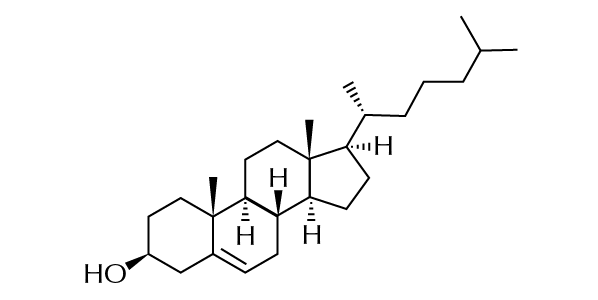What Is Cholesterol?
Cholesterol is an ingredient you will probably be familiar with in relation to general health. However, you probably won’t be familar with cholesterol in the context of skin health.
Cholesterol is an organic molecule that is added to cosmetics and skincare products to help support the skin’s natural barrier function and improve the moisture content. Cholesterol functions as a skin-conditioning agent and an emulsifier.
Cholesterol can be classified as a sterol, a type of lipid or oil molecule. It is synthesized by all animal cells and has also been isolated from plants. Cholesterol is an essential structural component of all animal cell membranes, functioning to maintain both membrane structural integrity and fluidity.
Cholesterol is also used to synthesize a number of important hormones in the body. It is used to create steroid hormones, bile acid, and vitamin D. Cholesterol is one of the most widely studied naturally occurring organic compounds.
Most cholesterol-containing products will simply say ‘cholesterol’ on the ingredient label. However, this ingredient can also be listed as either wool extract or lanolin extract as cholesterol is commonly derived from both. Additionally, cholesterol of vegetable origin is primarily derived from squalene, which is a precursor for the synthesis of cholesterol in plants.
Formulations may contain concentrations of up to 5 percent cholesterol, but the majority of products have a cholesterol content of 0.1 to 1 percent. Cholesterol is primarily used in skin care products, eye and face makeup, hair care products, and shaving preparations.

Cholesterol
the good: Cholesterol helps to support the skin’s natural barrier health, improve the condition of the skin and contribute to the moisture of the skin.
the not so good: Cholesterol can be derived from either animal or plant-based sources.
Who is it for? All skin types except those that have an identified allergy to it.
Synergetic ingredients: Works well with most ingredients.
Keep an eye on: Nothing to keep an eye on here.
What Is The Function Of Cholesterol?
To better understand the functions of cholesterol as an ingredient in skin care products, it’s first important to explain the natural function of cholesterol in our skin.
You’ll find cholesterol as a natural component of the skin’s outermost layer or stratum corneum. The stratum corneum is often referred to as the skin’s natural barrier. The skin’s natural barrier is also composed of corneocytes, ceramides, and free fatty acids. Ceramides represent about 50 percent of the skin’s lipid layer, cholesterol about 25 percent, and other fatty acids making up another 10 to 15 percent.
A strong, intact barrier is important to keep moisture in and keep things like allergens, bacteria, and irritants out. When the barrier is weakened, these intruders can pass through the top layer of skin, causing damage that ultimately leads to common skin conditions such as acne, rashes, sensitive skin, and even signs of aging.
Skin’s natural barrier
Since the skin’s natural barrier contains cholesterol, this ingredient helps maintain proper barrier functioning by retaining moisture levels and regulating cell activity. It works to strengthen the outer structure of the skin and protect it from dehydration. Cholesterol also functions to repair skin that has been stripped of its natural lipids by things like exfoliating or applying an aggressive anti-aging treatment.
Sensitive skin
Due to its ability to strengthen and repair the skin’s natural barrier, those with delicate, sensitive, and dry skin types will likely benefit most from cholesterol-containing products.
Furthermore, since cholesterol levels in the stratum corneum decrease with age (approximately 40 percent by age 40), using cholesterol-containing products on aged skin could be very beneficial.
Emulsifer
Another function of cholesterol is to act as an emulsifier by keeping the water and oil parts of a formulation from separating. According to EFEMA, when water and oil are mixed together and vigorously shaken, a dispersion of oil droplets in water is formed. When shaking stops, however, the two ingredient types start to separate.
To address this problem, an emulsifier like cholesterol can be added to prevent splitting. Cholesterol forms a monomolecular layer around the emulsion droplet, which helps the droplets remain dispersed and produces a stable emulsion.
Can Using Cholesterol-containing Products Impact Your Blood Cholesterol?
It’s important to note that topically applied cholesterol will not have an impact on blood cholesterol.
Is Cholesterol Vegan?
Cholesterol can be a vegan ingredient, however, it can also be derived from animal byproduct ingredients such as lanolin or wool extract.
Vegetable sources include squalene, which is a precursor for the synthesis of cholesterol in plants.
If you are looking for a vegan product, make sure to check if the rest of the ingredients in the formulation are vegan. Also, ensure that the brand is cruelty-free.
Is Cholesterol Safe?
The safety of cholesterol in cosmetics and personal care products has been assessed by the Cosmetic Ingredient Review Expert Panel.
The Cosmetic Ingredient Review Expert Panel, is a group responsible for the independent evaluation of the safety and efficacy of skincare and cosmetic ingredients.
The Expert Panel evaluated the scientific data and concluded that cholesterol was safe as presently used in cosmetic products. In 2004, as part of the scheduled re-review of ingredients, the CIR Expert Panel considered available new data on this ingredient and reaffirmed the above conclusion.
The EU Cosmetics Directive permits cholesterol to be used in cosmetic products, so long as it complies with the animal-by-products regulations.
Clinical studies to evaluate the safety of topically applied cholesterol were conducted with products formulated with the ingredient. Most products were moisturizers containing 1.4 percent cholesterol. The cholesterol-containing products were minimal to mild primary and cumulative skin irritants but not sensitizers or photosensitizers.
References:
Pappas A. Epidermal surface lipids. Dermatoendocrinol. 2009;1(2):72-76.
Feingold KR. The outer frontier: the importance of lipid metabolism in the skin. J Lipid Res. 2009;50 Suppl(Suppl):S417-S422.







